LED Light Therapy: All You Need to Know
LED light therapy is an easy treatment that can treat a wide variety of skin concerns. See how does LED light therapy work and what are some LED light therapy benefits.
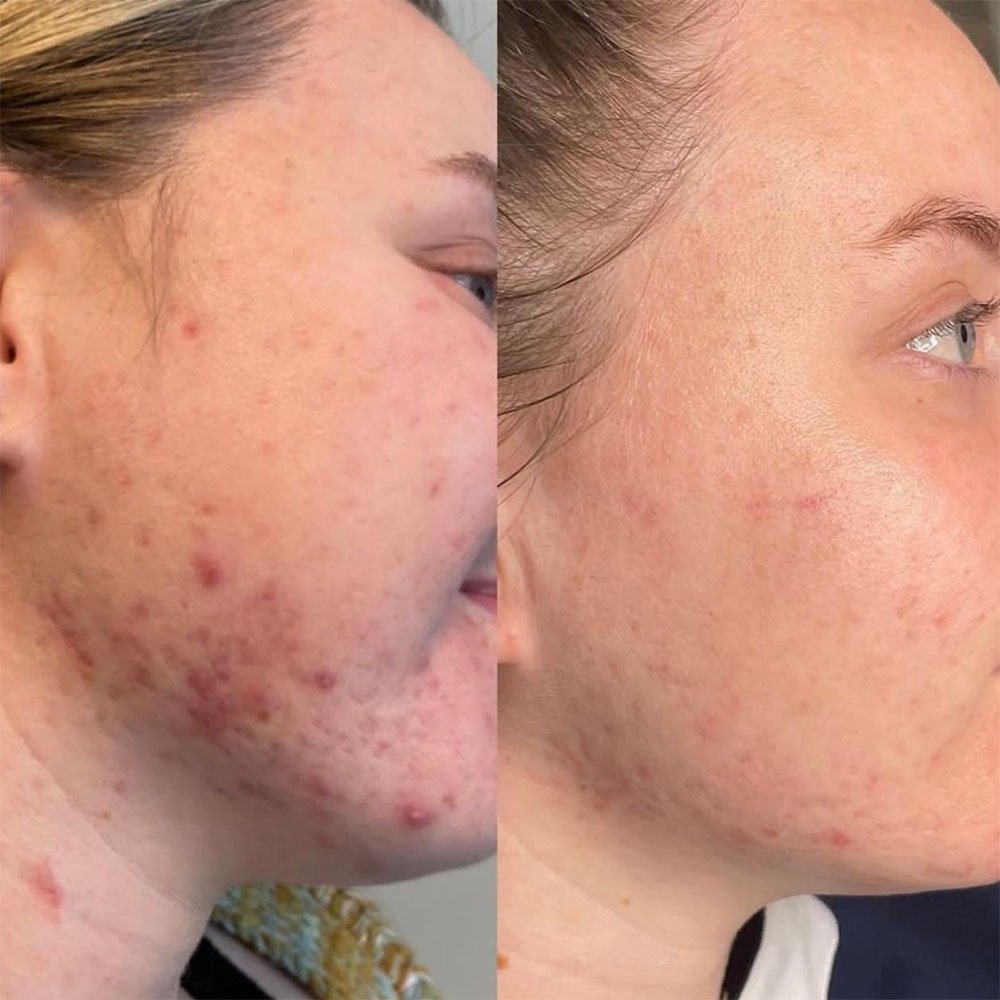
Image source : PMUhub
Explore more LED light therapy topics:
The use of LED light therapy has recently become more popular. This skincare treatment reportedly promotes anti-aging and anti-acne effects and helps treat a wide variety of skin conditions – without harming your skin at all.
Although this treatment is currently having its time in the spotlight – does it actually live up to the hype? Here’s how LED light therapy works, what benefits you can get from it, and everything else you need to know before booking an LED light treatment.
What Is LED Light Therapy?
LED (which stands for the light-emitting diode) light therapy is a non-invasive skin treatment. It originated in the 1990s when NASA began experimenting with its effects to help promote astronauts’ wound healing.
LED helps cell and tissue growth which is why it’s used to treat a variety of skin issues, including psoriasis, acne, and fine wrinkles.
Besides these, LED lights can also provide other skincare benefits, which made this treatment very popular and widely used. Especially by celebrities.
LED light colors correspond to different frequencies, or wavelengths – each one producing a specific effect. So, depending on the color, your skin will react differently.
The most popular LED light treatment is red light therapy, which is great for collagen and elastin stimulation. But other colors are also very sought-after treatments. Clients with acne-prone skin usually get blue light therapy as it kills bacteria.
But more on LED therapy types later.
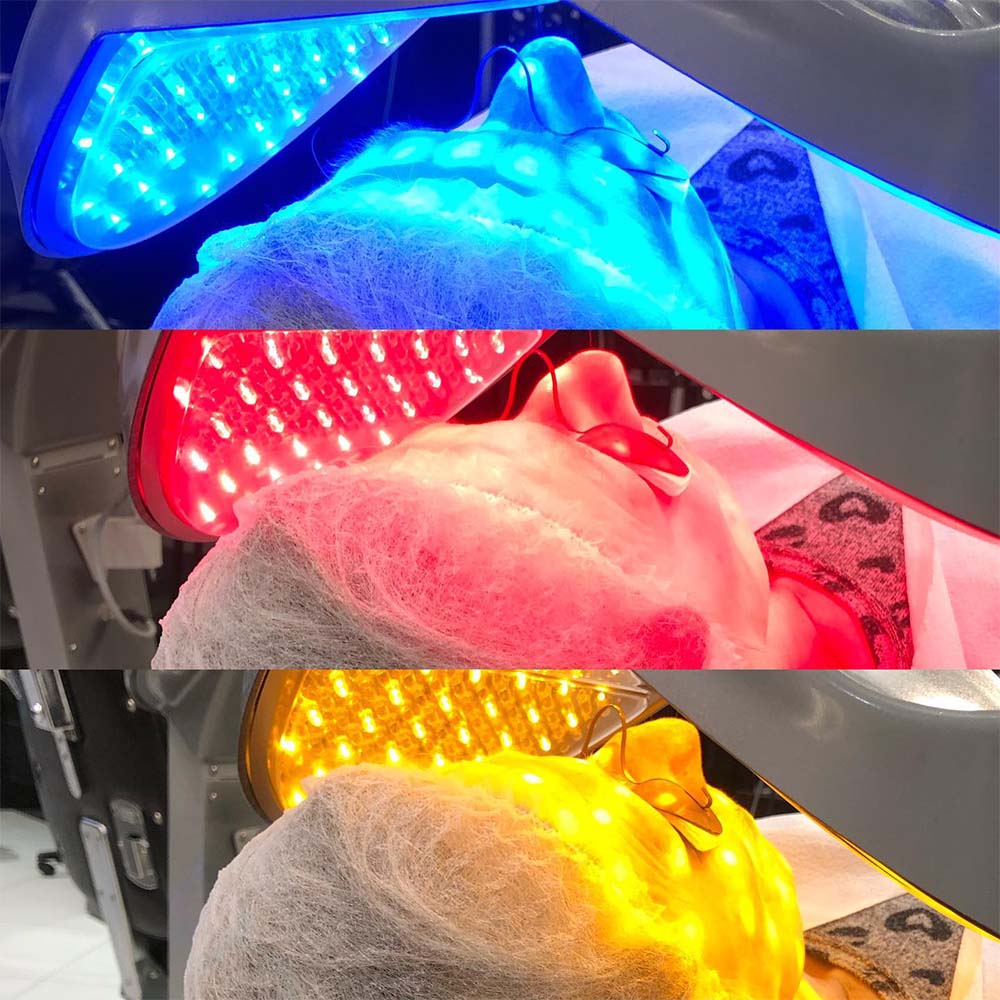
What Conditions Does LED Light Therapy Treat?
LED therapy is suitable for all skin types and skin tones and can treat a wide variety of skin conditions 1, such as:
- Fine lines and wrinkles
- Acne and acne scars
- Hair loss
- Wounds
- Skin conditions like dermatitis, eczema, psoriasis, and rosacea
- Sun damage
- Actinic keratosis (rough, scaly, precancerous spots on the skin)
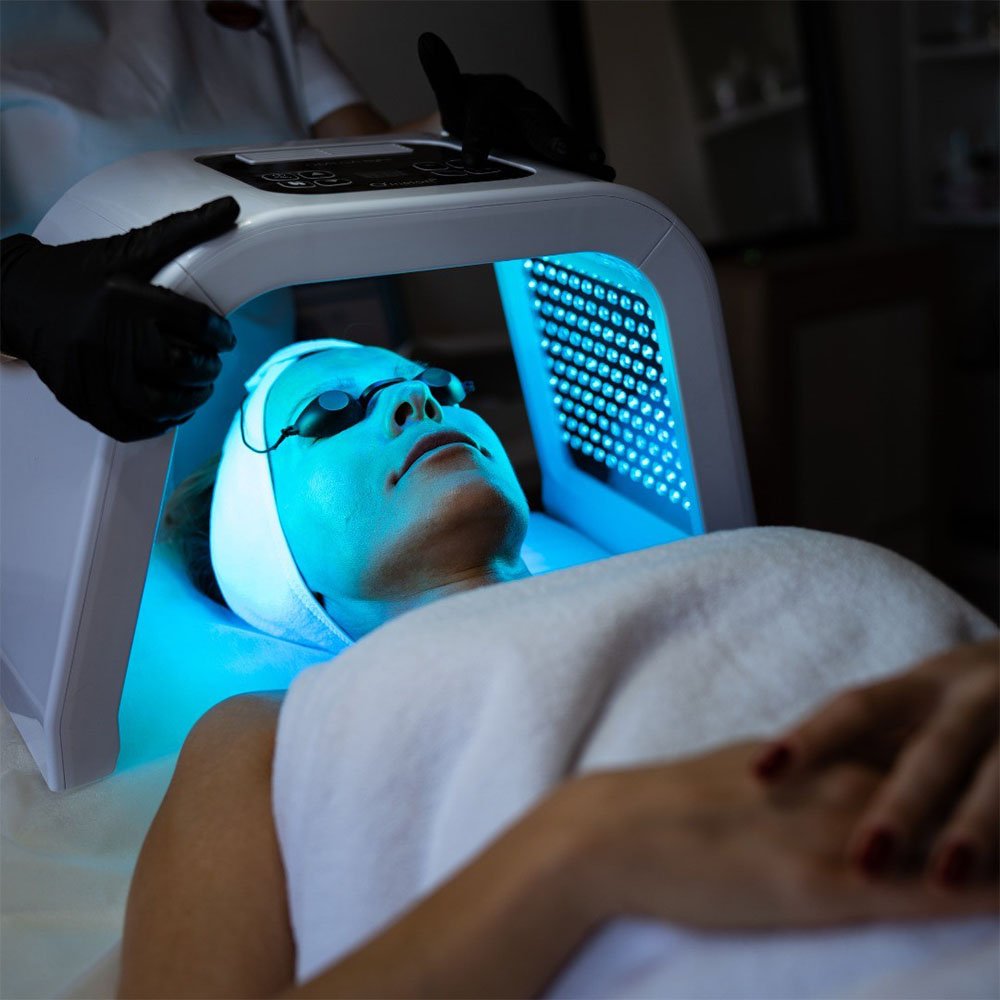
Limitations of LED Light Therapy
Like every other skincare treatment, LED light therapy for skin has some contraindications. LED light therapy isn’t appropriate for people who:
- Have a history of certain conditions, like skin cancer and inherited eye diseases
- Have taken certain medications that increase sun sensitivity, like isotretinoin
- Have sun sensitivity
- Have an active rash
- People who have psoriasis need to consult a doctor first.
Also, LED light for skin doesn’t help with:
- Acne cysts
- Blackheads
- Whiteheads
NOTE
Before booking LED therapy, consult a dermatologist. Whatever your skin problem is, it needs to be properly diagnosed in order to be treated right.
Not only will the dermatologist determine whether LED light therapy is the right choice for you, but will also recommend which specific one should be performed.
How Does LED Light Therapy Work?
In order to improve the skin, the LED device emits rays that penetrate the skin’s layers without causing any harm.
LED phototherapy devices send light waves deep into the skin to trigger natural intracellular reactions. These wavelengths, which are easily absorbed by the skin, do not include damaging UV light.
The way your skin reacts will vary depending on the light.
Usually, the client will require a series of LED treatments in order to experience any significant improvements. This will roughly be once a week for a month straight, after which you’ll need maintenance procedures every month or every few months.
LED Light Therapy Benefits
Besides treating specific skin conditions, LED therapy has other, more universal benefits, such as:
- Helps circulation and increases nutrient transfer
- Accelerates skin repair
- Improves skin elasticity and texture
- Increases collagen production
- Helps kill bacteria
- Helps skin increase moisture levels, making it more radiant
- Decreases inflammation.
Types of LED Light Therapy
The visible light spectrum is made up of several wavelengths, each of which corresponds to a different color. Each hue penetrates the skin to a different depth and achieves different effects.
So LED light therapy can be classified according to the colors.
Red Light Therapy
Red, or infrared, light is probably the most popular LED light therapy color – and probably the first association with this treatment.
It stimulates collagen proteins, which makes your skin look smoother and plumper. It’s mainly used to fight signs of aging by treating fine lines and wrinkles, as well as to reduce inflammation and improve blood circulation.
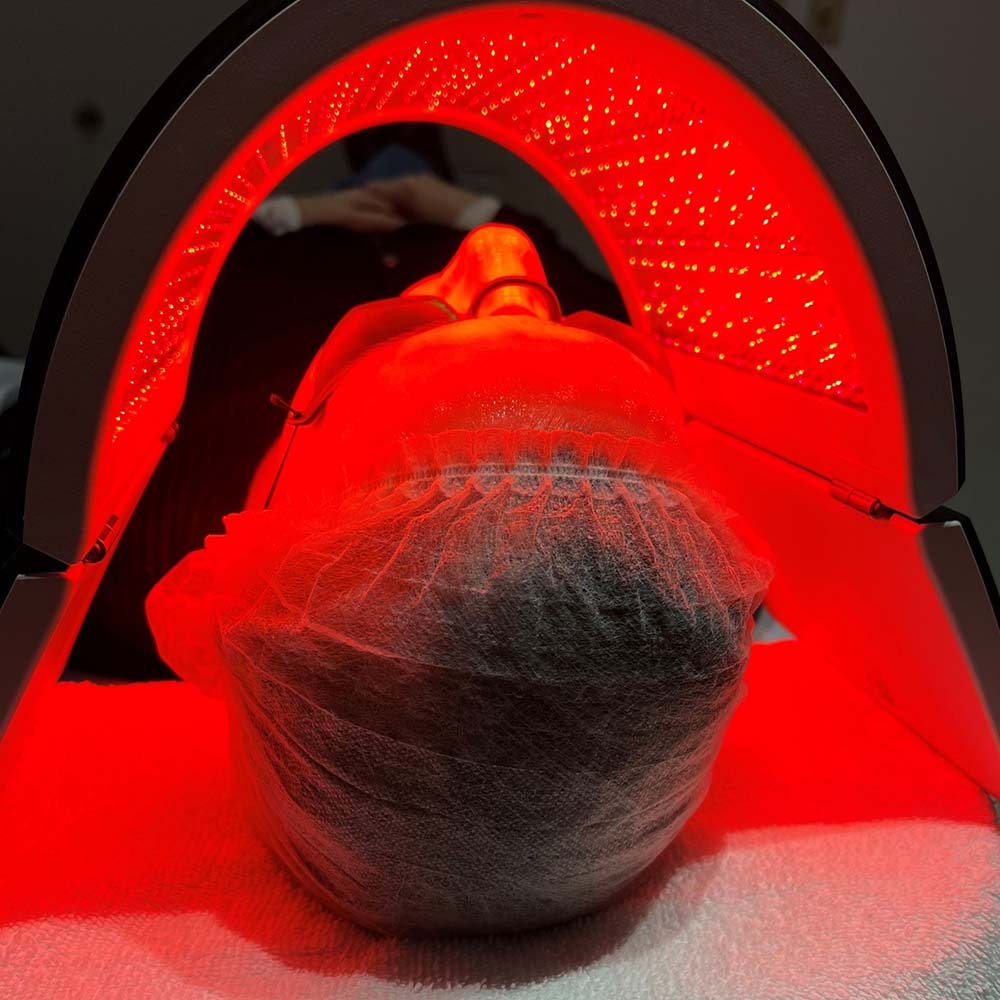
Blue Light Therapy
Blue LED light therapy targets the sebaceous (oil) glands that are in charge of keeping your skin from drying out. However, if these glands become overactive, excess sebum production usually leads to oily skin and acne.
Since blue light can kill acne-causing bacteria, blue light therapy for acne is used for clients that have acne-prone skin. This LED skin therapy can treat severe acne pimples, including cysts and nodules. It also helps make the glands less active and prevents future breakouts.
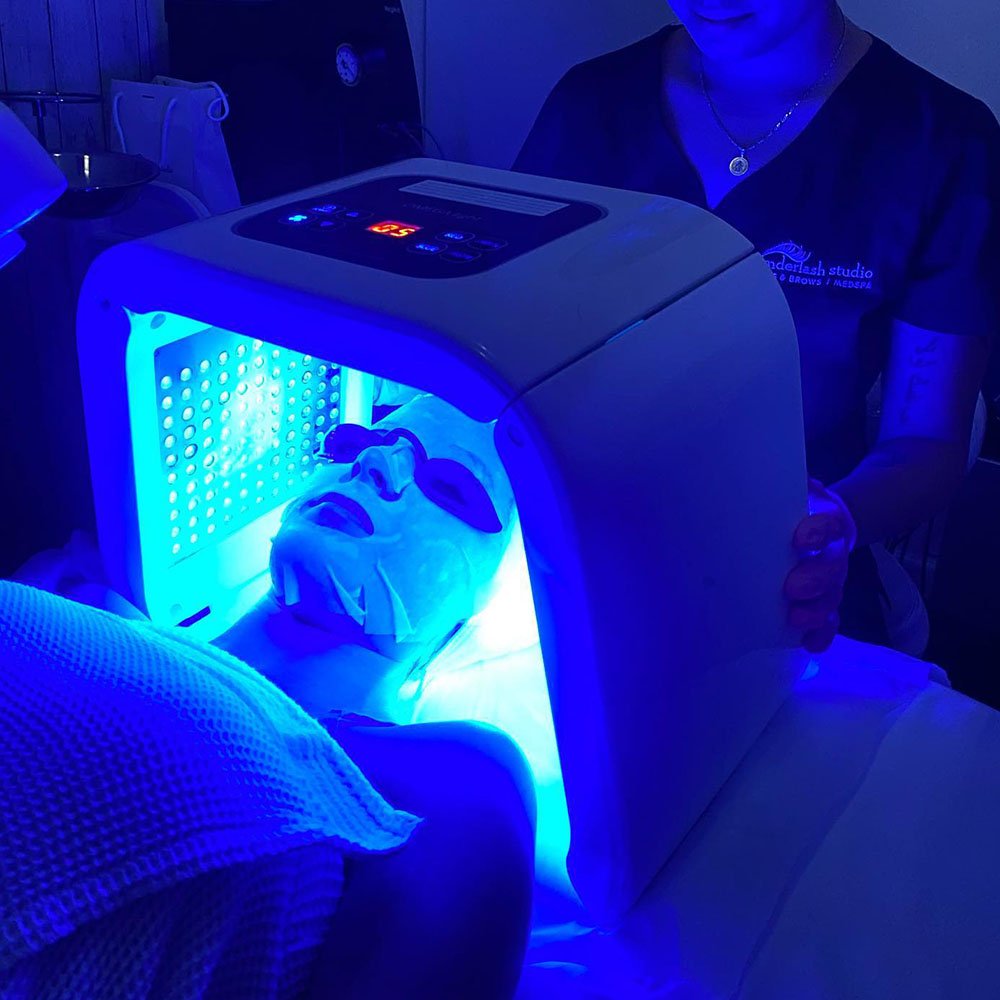
Yellow Light Therapy
Yellow light therapy is used for stimulating red blood cell synthesis – which is essential for skin healing and skin cell renewal.
It’s also believed to offer calming effects that aid in diminishing the visibility of dark patches, redness, and inflammation. But, since yellow LED light therapy has a shallow penetration level (in comparison to red), it’s mostly used for treating redness-related skin disorders, like rosacea.
Green Light Therapy
Green LED therapy has anti-inflammatory and skin-calming qualities which help soothe the skin’s top layer.
This can help fade hyperpigmentation, sun spots, and dark undereye bags. Dilated capillaries and sagging skin around the eyes can all be treated with green light therapy.
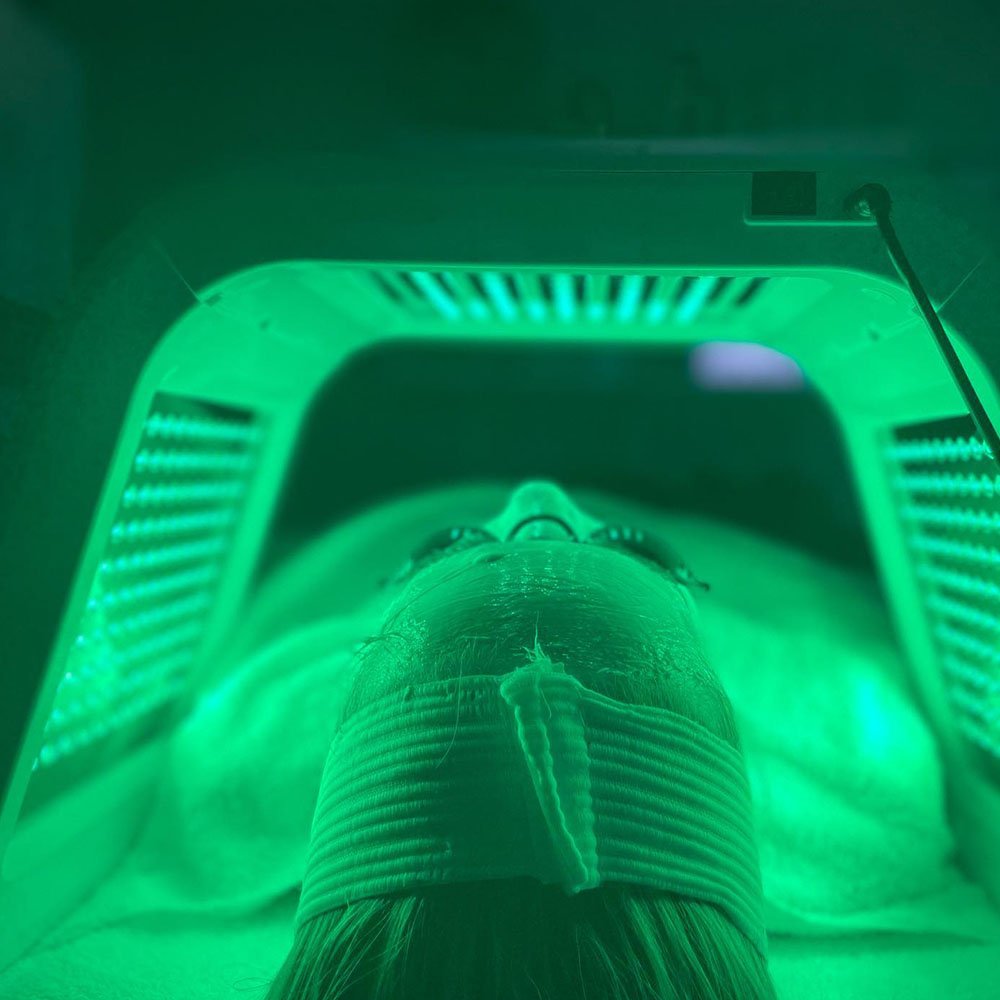
Cyan Light Therapy
Cyan, commonly referred to as blue-violet light, reduces inflammation, clears the skin, and prevents acne.
It also has a relaxing impact on the skin’s surface. Besides LED facial, cyan LED light therapy also helps improve cell energy and facilitate metabolism.
Purple Light Therapy
Purple LED light therapy increases cell regeneration. It helps reduce the appearance of acne-related scars and helps fight acne itself. It’s also great for reducing redness and facial inflammation.
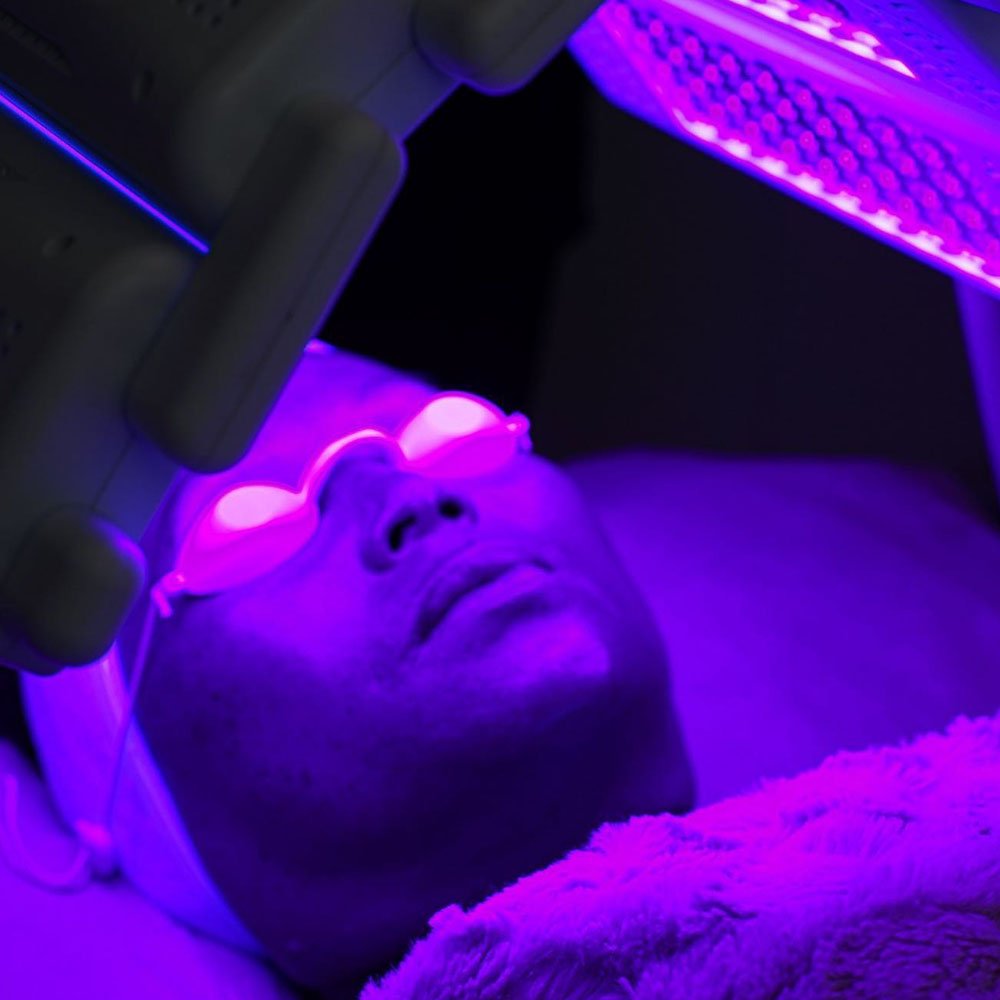
White Light Therapy
White LED therapy is essentially a combination of all the other lights, which makes it the most effective LED light therapy.
Using a full light spectrum means it includes the benefits of all wavelengths: it penetrates the skin deeply, accelerates tissue metabolism, corrects discolorations, and helps fight scarring, fine lines, and aging signs.
On top of that, it also kills bacteria which helps prevent and fight acne.
What Parts of the Body Can Be Treated?
LED light therapy is mostly employed as a LED facial. However, it’s not exclusively a face light therapy. It can also be used to treat any other part of the body, such as the neck and chest.
Areas that frequently exhibit aging symptoms, the neck, and hands can also benefit from light therapy for skin. However, you must receive regular treatments if you want to notice any improvements.
LED Light Therapy – Step-by-Step Process
This is a very quick and simple procedure. It only requires a few steps:
Step 1 – Prep
Preparation for the treatment isn’t complicated at all. You don’t have to do anything drastic to get your skin ready for LED skin therapy.
The only thing you need to skip is any form of chemical peels in the days leading up to your treatment(s). Other than that, you can perform your skincare routine as usual on the days leading up to your appointment.
Before the treatment itself, your skin should be clean and makeup-free. The technician will wash your face with a gentle, non-irritating cleanser.
But they also might apply some additional serums or other skin care products, depending if you receive additional treatments before LED light therapy.
The last step of the prepping process is putting on protective goggles or glasses so that the light doesn’t cause any damage to your eyes.
Step 2 – During the Treatment
After putting on your protective eyewear, the LED light treatment device will be placed above your face (or another body part).
Depending on the device, some providers may have you sit or lie down right in front of the lights, while others will apply LED light-infused wands to your skin. This step also depends on which body part you are looking to treat.
During the LED light treatment, you won’t feel any pain. There are no burns or skin abrasions brought on by the light. You might experience some warmth but no discomfort throughout the procedure.
Most clients report the colored lights are even quite soothing.
LED light therapy sessions take about 20 minutes at a time. Depending on the results you hope to get, you may need up to 10 treatments, each of which is spaced out about a week apart.
Step 3 – Finishing Up
After the right amount of time passes, the procedure is finished off with moisturizer and sunscreen. Some technicians like using serums and masks before or during the procedure, but that depends on the device manufacturer’s recommendations.
So serums can also be applied at the end of the treatment. Most often it’ll be hyaluronic acid, as its universally beneficial ingredient, but vitamin C serum or growth factors are also great options.
What to Expect After LED Light Therapy
After just one session, you may notice a few minor results. However, some more noticeable improvements will become apparent only after you’ve completed all the sessions.
Keep in mind that the results don’t last forever, even after you’ve completed the recommended amount of sessions. Your skin cells will continue to renew themselves, so you might start seeing signs of aging again as you lose some collagen without additional incentive.
Acne outbreaks may also start to appear. This is the reason why it’s advised that you return for maintenance treatments every few months or as your technician directs.
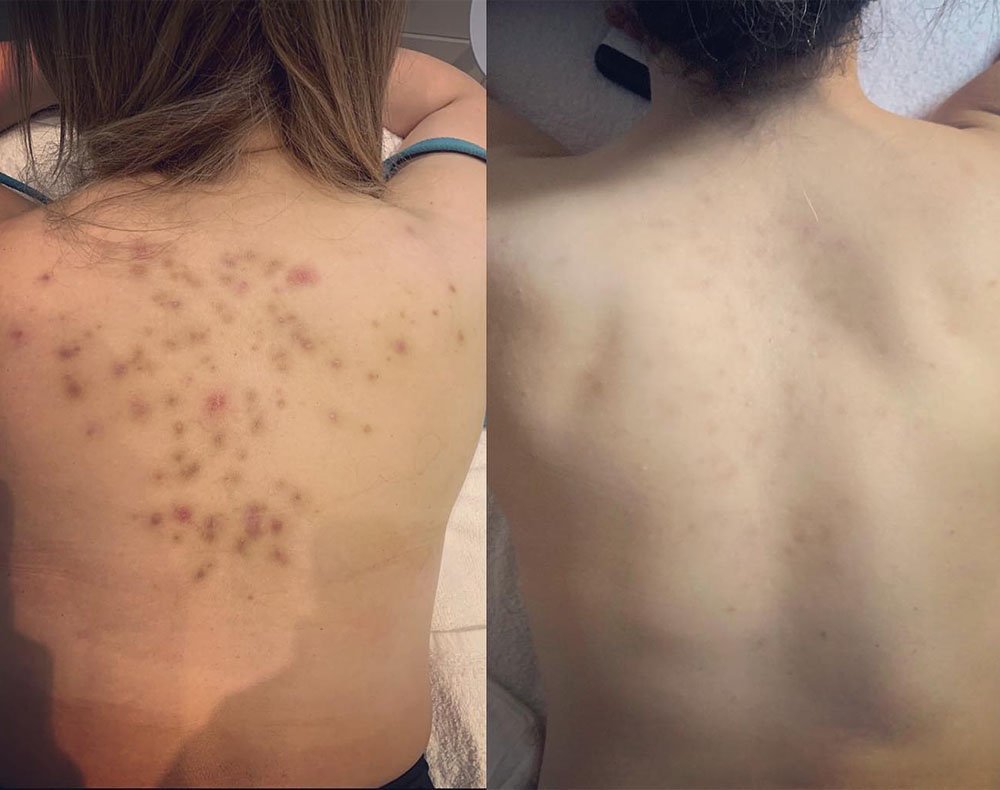
LED Light Therapy Aftercare
LEDs don’t damage your skin as more intrusive techniques do. And since it’s pain-free and noninvasive, there is no downtime needed. You should be able to continue with your daily routine as soon as the treatment is over.
Make-up and skincare wise, this is one of the rare treatments that doesn’t prohibit any ingredient. Make-up can be applied immediately after, but mineral and non-comedogenic formulations are recommended.
You also don’t need to avoid any skincare product post LED treatment. This treatment even amplifies its influence, so unless your technician suggests otherwise, you can use the product right away.
Just stay out of the sun for several days and apply extra sunscreen – at least 48 hours after LED treatment. Also, make sure you drink plenty of water to maintain hydration levels.
LED Light Therapy Risks & Side Effects
Since LEDs don’t contain UV rays, the American Academy of Dermatology deems this procedure safe.
Although experiencing side effects from LED light therapy is rare, if they do occur it’ll be manifested as:
- Increased inflammation
- Rash
- Hives
- Dry skin
- Redness
- Stinging or burning sensations
- Tenderness of the skin
- Pain
- Swelling
- Thermal burns
- Eye strain and temporary headaches caused by the light
If you notice these signs post LED light therapy, contact your doctor immediately.
NOTE
Experts warn that while light therapy for skin seems to be safe in the short term, there’s no concrete information about its long-term effects.
There have been some claims that light therapy can lead to premature aging of the skin and an increased possibility of skin cancer development later in life. But this claim isn’t backed by studies which focus on this treatment as a facial.
How Much Does LED Light Therapy Cost?
Although LED therapy is most often used in combination with other treatments, it is also available alone so the LED light therapy facial often ranges between $150 to $300.
When done without any add-ons, a single session can cost anywhere from $25 to $85.
Keep in mind that you’ll need multiple (even up to 10) sessions to see the results, so take that into the account for the overall cost.
At-home LED devices are, however, a more profitable solution, considering the device is yours to keep and use for further treatments. The cost ranges from $25 to well over $250.
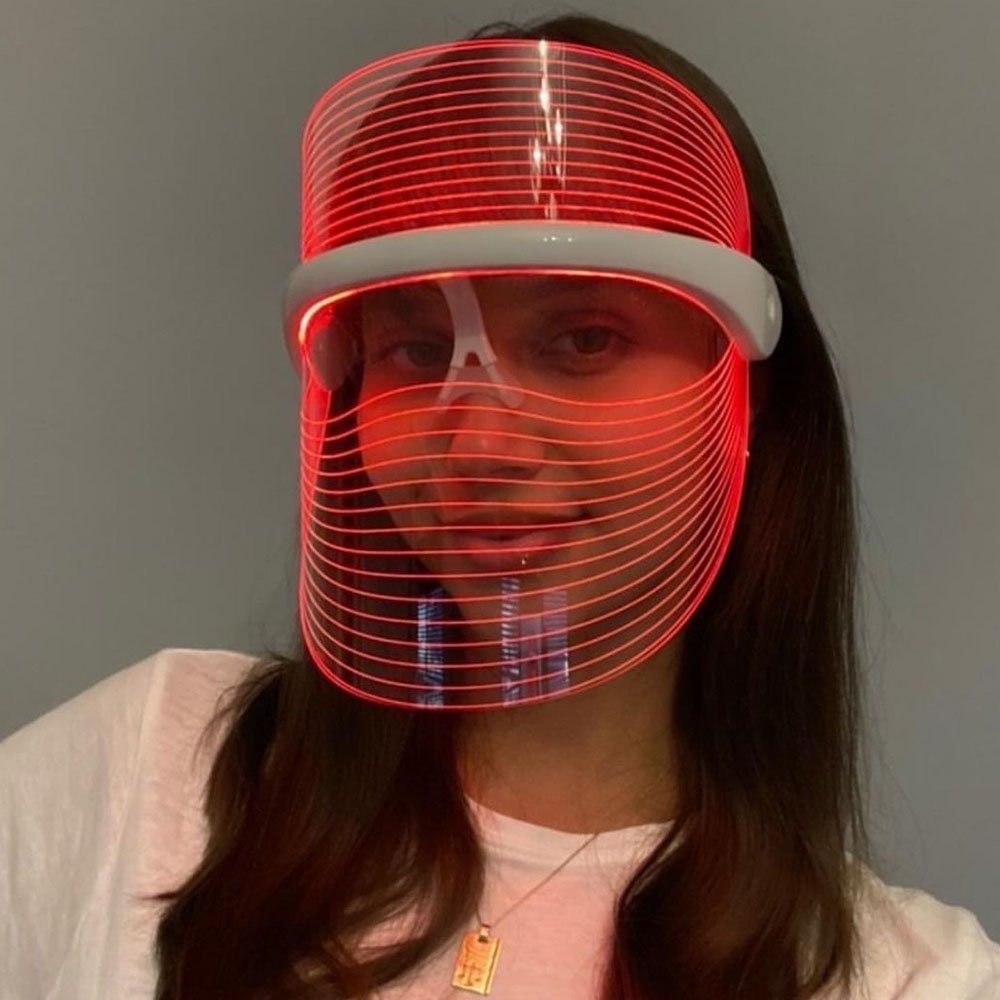
LED Light Therapy at Home
When it comes to doing LED light therapy at home, it’s important to note that the result won’t be as dramatic as an in-office appointment will give. The strength of in-office treatments allows them to penetrate the skin deeper and achieve anti-aging or acne-reducing benefits.
But, while at-home devices don’t employ as much intensity, it doesn’t mean you won’t get changes in the appearance of your skin.
LED technology can be seamlessly incorporated into your routine. There are many at-home gadgets, including LED light therapy mask, wand, and other handheld devices.
The instructions for each device are different, so make sure you’re following the directions carefully. First-time users might not use it properly, which is not only a waste of time and money but can also harm your skin! Also, don’t forget eye protection!
LED Light Therapy – Main Takeaways
LED light therapy is a great non-invasive skin treatment that can be used for a variety of skin (and even some health) issues, depending on the chosen wavelength.
The only downside of LED treatments is that the results, although impressive, aren’t long-lasting. So, LED light therapy—especially LED light masks for at-home use, should be viewed more as a useful addition to your skincare routine.
weekly insight into PMU insdustry
Subscribe to our FREE newsletter. 100% good stuff.

support us so we can keep providing you with free education , information and inspiration.
